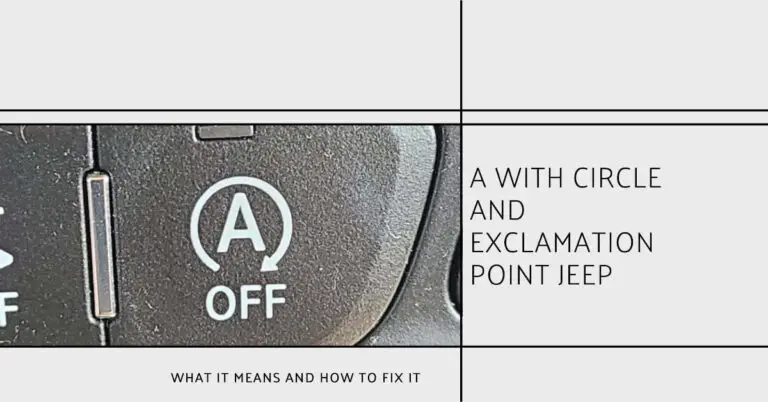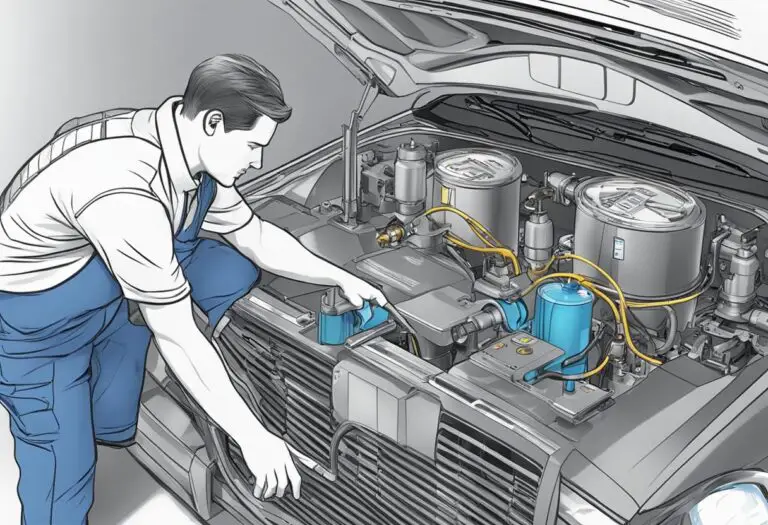Why Your Car Jerks When Accelerating (And How to Fix It)

Have you ever noticed your car jerking or sputtering when you accelerate? This frustrating feeling can make you late for work and leave you wondering what’s wrong with your vehicle.
If your car jerks when accelerating, it’s usually a clear sign there’s an issue somewhere that needs your attention. The jerky motion is often caused by engine misfires, transmission problems, or poor fuel supply. Fortunately, there are several common reasons why your car jerks when accelerating, and many are easy fixes you can tackle yourself.
In this article, we’ll explore the top 18 reasons your car jerks when accelerating and how you can troubleshoot and fix the problem. Read on to restore smooth and reliable acceleration in your vehicle.
Table of Contents
1. Faulty or Dirty Spark Plugs
Spark plugs are crucial for getting your engine to run smoothly because they provide the spark needed to ignite the air and fuel mixture within the cylinders. Faulty or dirty spark plugs are a common reason for engine misfires, which can make your car jerk when accelerating.
Here are some signs of bad spark plugs that should prompt you to check them:
- Reduced gas mileage
- Difficulty starting your engine
- Rough idle
- Misfires or sputtering acceleration
- Flashing check engine light
To fix the issue, you’ll need to remove and inspect the spark plugs. Look for cracks in the porcelain insulator, excessive oil or carbon deposits on the plugs. If the electrodes are worn or burnt, you’ll need to replace them with new spark plugs gapped to your vehicle’s specifications.
Replacing spark plugs is an easy DIY fix that can restore smooth acceleration in your car. Just be sure to use the spark plug brand and model recommended for your specific vehicle.
2. Issues with the Distributor or Distributor Cap
If your car has a distributor, deteriorating distributor cap can cause misfires, stalling, and jerking movements. The distributor cap redirects the ignition spark to the correct cylinder and distributes voltage to the spark plugs. If the distributor cap is cracked, corroded or has broken ignition contacts, it can cause your engine to misfire as you accelerate.
Distributor cap issues can produce symptoms like:
- Difficulty starting your car
- Stalling at intersections
- Sputtering acceleration
- Flashing check engine light
Inspect the distributor cap for cracks, moisture, and corrosion. Examine the ignition rotor for wear and damage. Check that spark plug wires are intact and securely attached. If you find any damage, replace the distributor cap and ignition rotor button right away. This can stop erratic engine behavior and jerking as you accelerate.
3. Dirty or Clogged Fuel Injectors
Your car’s fuel injectors deliver pressurized fuel into the engine cylinders to mix with air. But over time, gum, varnish and carbon deposits can build up inside the injectors, restricting optimal fuel flow. Clogged injectors can’t properly atomize and deliver fuel, causing your engine to misfire.
Here are some common clues that your fuel injectors might need cleaning:
- Poor acceleration
- Rough idle
- Reduced gas mileage
- Dark tailpipe exhaust
- Gasoline smell from car
- Flashing check engine light
To clean clogged fuel injectors, first try running some injector cleaner additive through your gas tank. If that doesn’t solve the issue, a professional mechanic can thoroughly clean your car’s injectors using specialized tools. Replacing a severely clogged fuel injector may be needed.
Proper fuel injector cleaning can restore strong spray patterns for smooth acceleration performance. Consider getting your fuel injectors professionally cleaned every 25,000 miles or so to maintain your car’s acceleration and power.
4. Worn Out Transmission
The transmission is responsible for smoothly shifting gears as your vehicle accelerates and decelerates. Like any component, the transmission wears out over time. Automatic transmissions are especially prone to slipping and hard shifts as internal clutches and gears degrade.
Symptoms your transmission might be wearing out include:
- Delayed or hard gear shifts
- Jerking or shuddering while shifting gears
- Unusual noises during acceleration
- Slipping between gears
- Check engine light illuminated
If you notice any of these warning signs, avoiding hard acceleration and high loads until you can have your transmission inspected. A rebuild or replacement may be needed for very worn transmissions. Addressing transmission problems quickly can help prevent further damage and restore smooth gear changes.
5. Clogged Air Filter
A dirty, clogged air filter restricts airflow into your car’s engine, reducing power and acceleration. Your engine needs clean air to mix with fuel for proper combustion.
Here are some signs your air filter needs to be changed:
- Decreased acceleration performance
- Higher than normal RPM when accelerating
- Rough idling
- Reduced fuel mileage
- Engine misfires
Replacing a clogged air filter is fast and easy. Just locate your air filter, typically inside the air filter housing attached to the engine. Remove the old filter and clean out any debris. Insert a new air filter, close up the housing, and you’re done. Proper air flow is restored, eliminating acceleration issues related to a dirty air filter.
Plan to replace your air filter every 12,000 to 15,000 miles to keep your engine running smoothly. Use your vehicle manual to find the recommended service interval.
6. Faulty Oxygen Sensor
The oxygen or O2 sensor monitors oxygen levels in your car’s exhaust stream. It sends data to the engine computer to enable proper fuel combustion. A bad oxygen sensor provides inaccurate readings, which can throw off the air/fuel ratio and cause misfires.
Here are some faulty oxygen sensor symptoms that can make your car jerk or hesitate when accelerating:
- Hard starting problems
- Rough idling
- Poor fuel economy
- Failed emissions test
- Check engine light illuminated
You can use an OBD-II scanner tool to check for diagnostic trouble codes that point to a faulty oxygen sensor. Plan to replace your oxygen sensors approximately every 100,000 miles or 10 years. Using an O2 sensor socket and wrench makes the replacement job much easier.
7. Issues with the Catalytic Converter
Your car’s catalytic converter works to reduce emissions by converting pollutants into less harmful gases. But over time, catalyst breakdown inside the converter can plug the exhaust and restrict flow. A failing catalytic converter limits exhaust output, potentially causing acceleration problems.
Signs your catalytic converter might be failing include:
- Reduced engine performance
- Jerky acceleration
- Strong sulfur or rotten egg smell from exhaust
- Flashing check engine light
Replacing a failing catalytic converter will remove the exhaust flow restriction to prevent sputtering acceleration. Your local muffler shop can diagnose catalytic converter issues and handle the replacement job. Expect to pay $400 to $1200 for a new catalytic converter, including parts and labor.
8. Problems with the Fuel Pump
To operate properly, your car’s engine needs consistent fuel pressure and volume from the fuel pump. A failing fuel pump can’t deliver the fuel needed for smooth acceleration.
Here are some symptoms of fuel pump failure:
- Whining noise from fuel tank
- Difficult starting or engine not turning over
- Jerky acceleration
- Loss of power
- Check engine light comes on
You may be able to confirm fuel pump issues with simple diagnostic tests. Turn the key to the ON position without cranking the engine and listen near the fuel tank for a humming noise. If the sound is weak or non-existent, the fuel pump could be failing.
Replacing the fuel pump restores consistent fuel pressure for smooth acceleration performance. If you have access to a lift or pit, the job is fairly straightforward. Otherwise, this repair is best left to a professional mechanic.
9. Engine Misfires
Engine misfires are one of the most common reasons for jerky acceleration. Misfires happen when there’s an interruption of proper ignition in the engine’s cylinders. Weak spark, poor compression, or incorrect fuel mix can all cause misfires.
You may feel engine misfires as subtle stumbles or as pronounced jerks when accelerating. Other symptoms include:
- Flashing check engine light
- Rough idle
- Loss of power
- Increased emissions
Diagnosing misfires requires testing components like ignition coils, spark plugs, injectors, vacuum hoses, valves, and cylinders for issues. Replacing faulty components causing misfires will stop jerky car acceleration and restore smooth performance.
10. Loose Fuel Line
Your car’s fuel lines carry gasoline from the tank to the engine. If connections become loose, fuel flow can be interrupted, potentially causing sudden jerking movements when accelerating.
Warning signs include:
- Smell of gasoline around car
- Wet spots on pavement below fuel line
- Difficulty starting engine
- Sputtering acceleration
Inspect fuel lines for leaks, damage, and loose fittings. Tighten any loose connections with the proper size wrench. Replace any cracked or damaged fuel lines. Proper fuel line tightness prevents acceleration issues related to fuel leaks or interruptions.
11. Worn Out Engine Mounts
Engine mounts secure your powertrain to the vehicle frame, while absorbing engine vibrations and movement. When mounts wear out, it allows excessive engine movement that can impact acceleration. Bad mounts can also cause clunking or knocking noises under load.
If you suspect bad engine mounts, check for symptoms like:
- Excessive engine movement when accelerating
- Knocking or clunking under acceleration
- Jerky movement when shifting gears
- Cracked or torn mount rubber
Replacing worn engine mounts restores secure engine positioning for smooth acceleration performance. Just be sure to replace all mounts at the same time to prevent uneven binding or failure.
12. Issues with Mass Airflow Sensor
The mass airflow (MAF) sensor calculates the volume of air entering your engine to determine optimal fueling needs. If this sensor is dirty or defective, it sends incorrect data to your car’s computer. This can cause various drivability issues including jerky acceleration.
Warning signs of a bad airflow sensor include:
- Hard starting problems
- Stalling at stops
- Rough idle
- Reduced power and acceleration
- Check engine light comes on
You can try cleaning the MAF sensor with aerosol electronics cleaner to restore proper functionality. If that doesn’t work, replacement of the mass airflow sensor is needed. Your acceleration should become normal once the accurate air readings are restored.
13. Problem with the Throttle Body
The throttle body controls air flowing into the engine based on gas pedal position. A dirty or failing throttle body can’t properly regulate airflow, potentially causing acceleration issues.
Symptoms of throttle body trouble often include:
- Delayed or jerky acceleration
- High or low idle speeds
- Engine misfires
- Check engine light comes on
You may be able to resolve dirty throttle body symptoms by cleaning the housing and plate with throttle body cleaner. Replacement is required if the throttle body is damaged internally. Getting your throttle body fully functional again provides smooth acceleration response.
14. Vacuum Leak
Your engine requires robust vacuum to run optimally. A vacuum leak can throw off air/fuel ratios by allowing unmetered air to enter the intake manifold. This lean condition often produces misfires and jerky acceleration.
Signs of a vacuum leak include:
- High idle speed
- Rough idle
- Hesitation or jerking when accelerating
- Check engine light illuminated
Inspect all vacuum hoses for cracks, damage, and loose connections. Spray a small amount of carburetor cleaner around hoses and intake gaskets while engine is running. If RPMs rise, a vacuum leak is present. Replacing damaged vacuum hoses and tightening loose fittings will eliminate vacuum leaks and related acceleration issues.
Fixing Your Car’s Acceleration Problems

While it can be alarming when your car jerks or hesitates when accelerating, in most cases the culprit is a minor maintenance item like replacing spark plugs or cleaning fuel injectors. Following the common issues above, you can hopefully narrow down what’s causing the problem based on your symptoms and service needs.
Don’t ignore sputtering or jerky acceleration problems for too long. Taking quick action helps prevent further engine damage and avoids bigger repairs down the road. If the issue ends up being complex for your DIY abilities, it’s wise to have a professional mechanic properly diagnose and fix your vehicle.
Now that you know what commonly makes cars jerk when accelerating and how to restore smooth performance, you can have confidence addressing this annoyance if it happens in your vehicle. Just stay alert to any acceleration changes and respond right away to keep your car running reliably for the long haul.
Here’s a quick recap of what we covered:
- Spark plugs – Faulty or dirty spark plugs are a common reason for engine misfires and jerky acceleration. Inspect and replace worn spark plugs if needed.
- Distributor – Issues with the distributor cap or rotor can interrupt spark delivery and cause sputtering acceleration. Replace damaged parts.
- Fuel injectors – Clogged injectors prevent optimal fuel atomization, leading to misfires. Try injector cleaner additive or professional cleaning.
- Transmission – Worn clutches and gears in an automatic transmission lead to slipping and jerky shifts. Have your transmission inspected and serviced.
- Air filter – A clogged air filter reduces engine power and acceleration. Simply replace dirty air filters.
- Oxygen sensor – A bad oxygen sensor provides inaccurate readings that throw off the air/fuel ratio and cause acceleration issues.
- Catalytic converter – A restricted catalytic converter limits exhaust flow out of the engine, hampering acceleration. Replace a faulty catalytic converter.
- Fuel pump – A failing fuel pump can’t deliver consistent fuel pressure needed for smooth acceleration. Test and replace the fuel pump if needed.
- Engine mounts – Worn engine mounts allow too much engine movement, impacting acceleration smoothness. Replace degraded mounts.
- Mass airflow sensor – Dirty or faulty airflow sensors send incorrect readings to the computer, leading to acceleration problems. Clean or replace the faulty sensor.
- Throttle body – Carbon buildup and internal failures affect airflow and create sputtering acceleration. Clean or replace the throttle.
- Vacuum leaks – Air leaks throw off air/fuel ratios, causing misfires and jerky acceleration. Inspect and replace damaged vacuum hoses.
Take action at the first sign of acceleration issues in your car for smoother performance. With patience and some targeted DIY repairs, you can successfully resolve jerky or sputtering acceleration problems.







